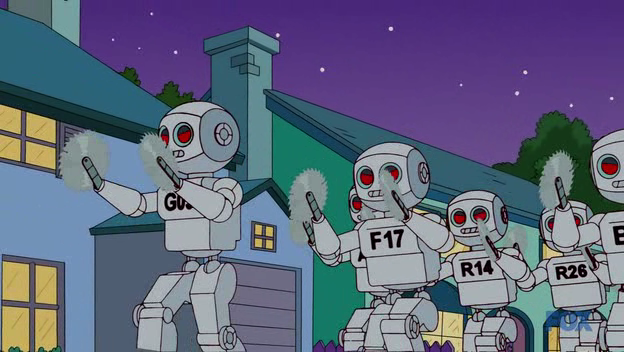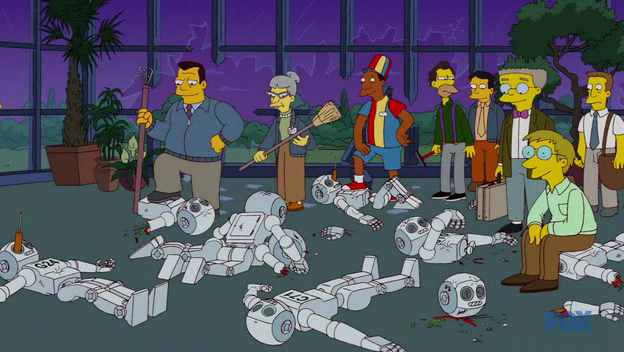“Wow, this is so much like my dreams, it’s scary.” – Bart Simpson
The robot apocalypse has been a staple of fiction literally since “robots” were first imagined. According to Wikipedia, the word “robot” was first coined for a Czech play about robots who, you guessed it, rise up and defeat us squishy humans. (Apparently, it’s a translation of the Czech word for “slave”. I learned something today.) That idea has been the foundation for who knows how many works of fiction, and has so thoroughly penetrated mainstream culture that making jokes about it is more or less obligatory every time some new advance in actual electronics is announced.
Most stories about robot uprisings occur in the realm of science fiction for the obvious reason that, as Linda Hamilton so eloquently put it back in 1984, “They cannot make things like that yet.”. Indeed, they cannot. This presents a problem for shows like The Simpsons and Zombie Simpsons, which have contemporary settings but still want to have some fun at the expense of our would be overlords.
Since this is fiction (and animated fiction at that), no problem is really insoluble. Whether you’re broadcasting in 1994 or 2012, if you want to have rebelling robots, you can have rebelling robots. The important question is how you go about it. You can work the robots into the larger framework of the episode, making them and their characteristics part of the setting and satire. Or you can just conjure them out of nowhere, strip them of all characteristics save the most grossly basic outline of a “robot”, and have them traipse around with no discernable rhyme or reason. The former is what The Simpsons did in “Itchy & Scratchy Land”, the latter is a roughly accurate description of whatever the hell it was Zombie Simpsons did in “Them, Robot”.
The Simpsons always had its share of improbable plots, but murderous robots was pretty far out there, even by their standards. Consequently, the episode is very deliberate about how it introduces the concept that will eventually be crucial to its ending. The first act is all about the family going on vacation, and doing so in very familiar terms: marketing gets kids to pester their parents, the parents eventually cave, and there’s a long and not terribly pleasant car ride. All of it is given that specially ludicrous Simpsons touch (Homer having a trunk full of fruits and vegetables, AM radio’s love of “signs of evil”, the shortcut), but there’s nothing that isn’t relatable to anyone who’s ever spent slow hours in the front or back seat on a family road trip.
The turn comes right before the first commercial break, when they go from the Itchy Lot to a helicopter that has a Jurassic Park style logo on the side and a pilot who confidently informs them that nothing can “possi-ply” go wrong as the Simpsons nervously glance at one another. It’s an obvious allusion to a massively popular science fiction movie, and the last shot before the ads is a rather terrifying looking island. Those last few scenes not only foreshadow the rest of the episode, they also subtly prepare the audience for the kind of events that are more often found in big budget science fiction.
I think Dr. Wily might be in there somewhere.
As an amusement park, Itchy & Scratchy Land is another great example of the way the show parodied ideas rather than brands. There’s plenty of Disney in the place (and Homer saying that he “kicked a giant mouse in the butt” remains a great dig), but it’s also mocking amusement parks more generally and the way that they have a narrowly controlled idea of what fun is. Disney World, Universal Studios and the like bill themselves has happy places, but underneath the gaudy surface are miserable employees, command systems that make them more like police states than parks, and a never ending hustle to make sure that there is no money left in your pocket when you leave the place. Anybody who has ever been to one can easily recognize all of these things, which makes suspension of disbelief about animatronic robots (another well known amusement park staple) that can walk upright and brutally attack each other that much easier.
When the audience is first introduced to the robots as part of a typical amusement park parade, we’re already primed to accept them as part of a recognizable (albeit exaggerated) landscape. And the show doesn’t waste any time either. Right in that first scene, we learn everything we need to about the robots: they’re armed, they don’t react well to flash photography, and they are programmed only to attack each other. These three characteristics remain constant throughout the episode, so when the revolt comes and they override their safety features (part of the ongoing Jurassic Park theme), no further explanation or exposition is necessary. The rules of this strange but familiar place have already been laid down, and the ending works within them.
You can draw a straight line from those first hints of danger right through to the end. As the story progresses, additional elements are seamlessly picked up so that when it does come time for a robot to go after Homer with an ax, there are no questions in the audience’s mind about why the robot is attacking or why it has an ax. The whole thing is so well constructed that they can actually have Homer make an exposition joke (“What are you, the narrator?”) without even slowing things down.
To compare with that intricate and comprehensive build up, Zombie Simpsons has some generic robots from somewhere, a power drill, and nothing else. The robots simply appear from behind a curtain with no reason or explanation given for how they came to be or how they got there. For the better part of the episode they stand idly by while Homer kills them in rather gruesome ways, forces them to play baseball, kills some more of them, and then sets a big pile of their twisted remains on fire. During all this, the robots alternate between being super strong and being incredibly fragile. The effect of all those manic actions, unannounced changes, and empty carnage not only undermines each scene, but the story as a whole.
For most of the episode, Homer’s been able to destroy individual robots with little more than a hard shove. The very first one he kills simply collapses to the ground after he bumped into it. Then he sticks a power drill into their heads and all of a sudden not only have their hands changed shape, but they’ve become frightfully capable of violence, including breaking through doors and windows and swatting away guard dogs with ease. The episode proceeds as though they are now all but invincible killing machines . . .
. . . right up until . . .
. . . they’re easily defeated by things which they would’ve torn through in the previous scene. The rampage ends just two minutes after it began by abruptly changing – yet again – the nature and capabilities of the robots.
Zombie Simpsons is no stranger to weak, illogical, or outright non-existent plots, of course. But it hurts them worse than usual in this context because the entire plot, as opposed to a scene or two, is predicated on something so strange and unbelievable that it kills any kind of flow or humor. All they’re left with is cheap silliness like corn dogs and squeegees. There’s nothing wrong with silliness, of course, but Homer didn’t defeat the robots when he threw his underwear at them.
The Simpsons pulled off their robot apocalypse because they treated it carefully, building up to what would’ve been head-exploding, laugh-killing nonsense had they introduced it earlier. Zombie Simpsons dove head first into that nonsense and never came up.




 charliesweatpants.com
(The crotch really does wear out too fast.)
charliesweatpants.com
(The crotch really does wear out too fast.)
It’s far from the first time they bring up something utterly crazy as a plot in order to impress their viewers, yet they fail to simply think through the plot itself and end up needing to go back to status quo within couple of minutes left before the end. Instead of developing the story what they rather do is come up with some filler here and there, a joke well-thought they congratulate themselves for (I hate it when a show does that), and end with either more jerkass Homer, everybody dancing or etc. leaving nothing at all explained or justified.
One day, one day it will all come to an end…
The only antidote to a zany scheme is an even zanier scheme!
“With a dry cool wit like that I could be an action hero.”
Itchy & Scratchy Land gave us dozens of quotable lines that can be used in everyday conversation. For me, that’s a measure of a well crafted Simpsons script. Last Sunday’s episode gave us nothing.
Re Itchy and Scratchy Land
More like Westworld than Jurassic Park in many respects.
Yeah it’s definitely more of a West World parody, especially the “nothing can possib-ply go wrong” quote (as the guests are entering West World a voice on the intercom is repeating the words “nothing can go wrong”).
Mind you, Jurassic Park is basically West World but with dinosaurs.
Great compare and contrast though. Almost makes me wish I was watching these episodes to appreciate it more, but I just can’t bring myself to do it!
Westworld is one of those movies I’ve been meaning to see for years but never quite gotten around to watching. Guess I’ve got some homework for this weekend.
Btw, just to point out: http://static.ddmcdn.com/gif/asimo-1a.jpg
2,3 seconds with Google and you have an original and totally hilarious robot concept.
I sure hope there is more pot because I’m tired now…
The sad part is that there’s a decent sci-fi concept story hidden in there somewhere but in typical ZS fashion they completely fuck up the execution. How are these people getting paid?
If the simpsons started out in ZS quality would Springfield be set in a state rather than being Springfield, USA?